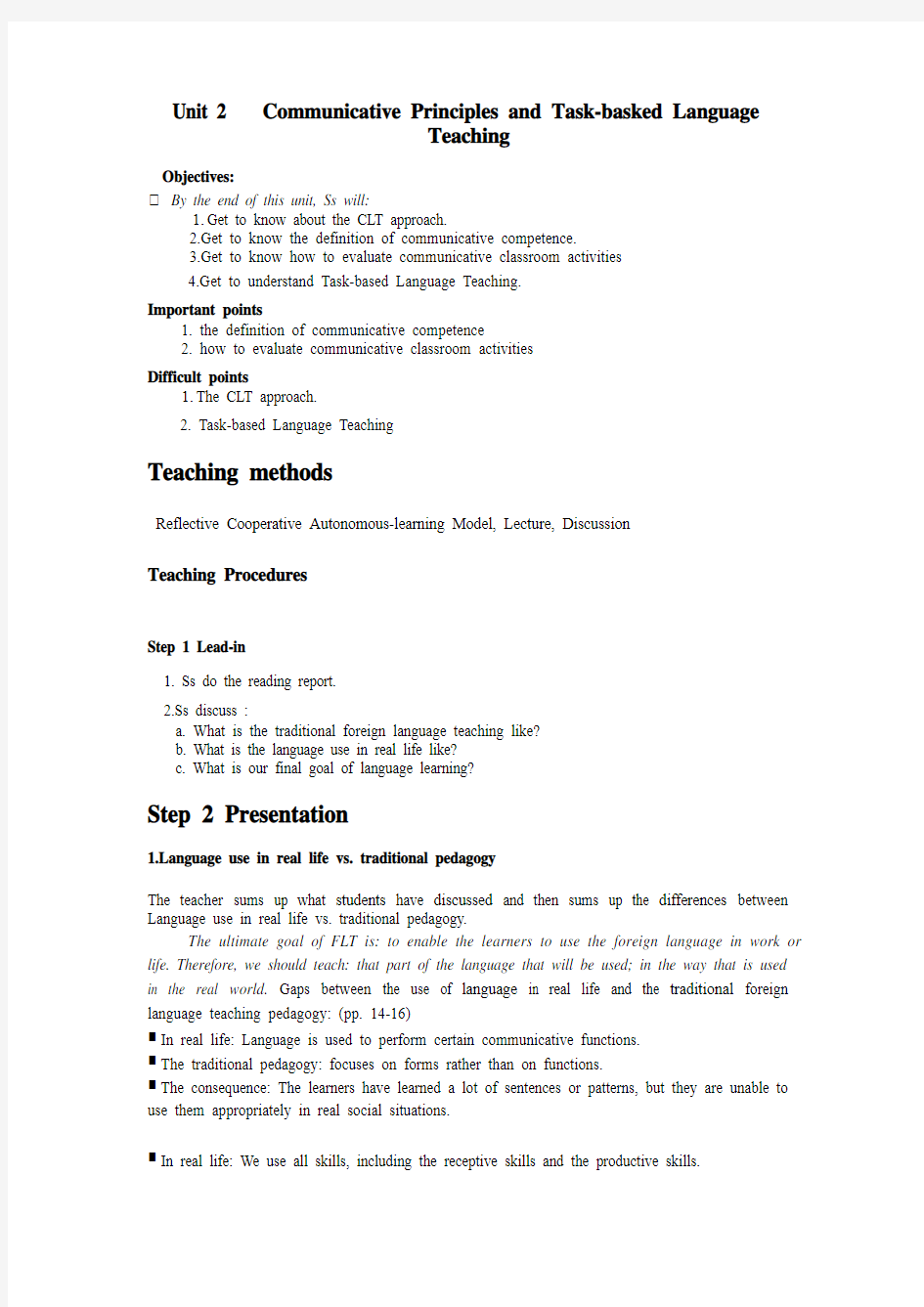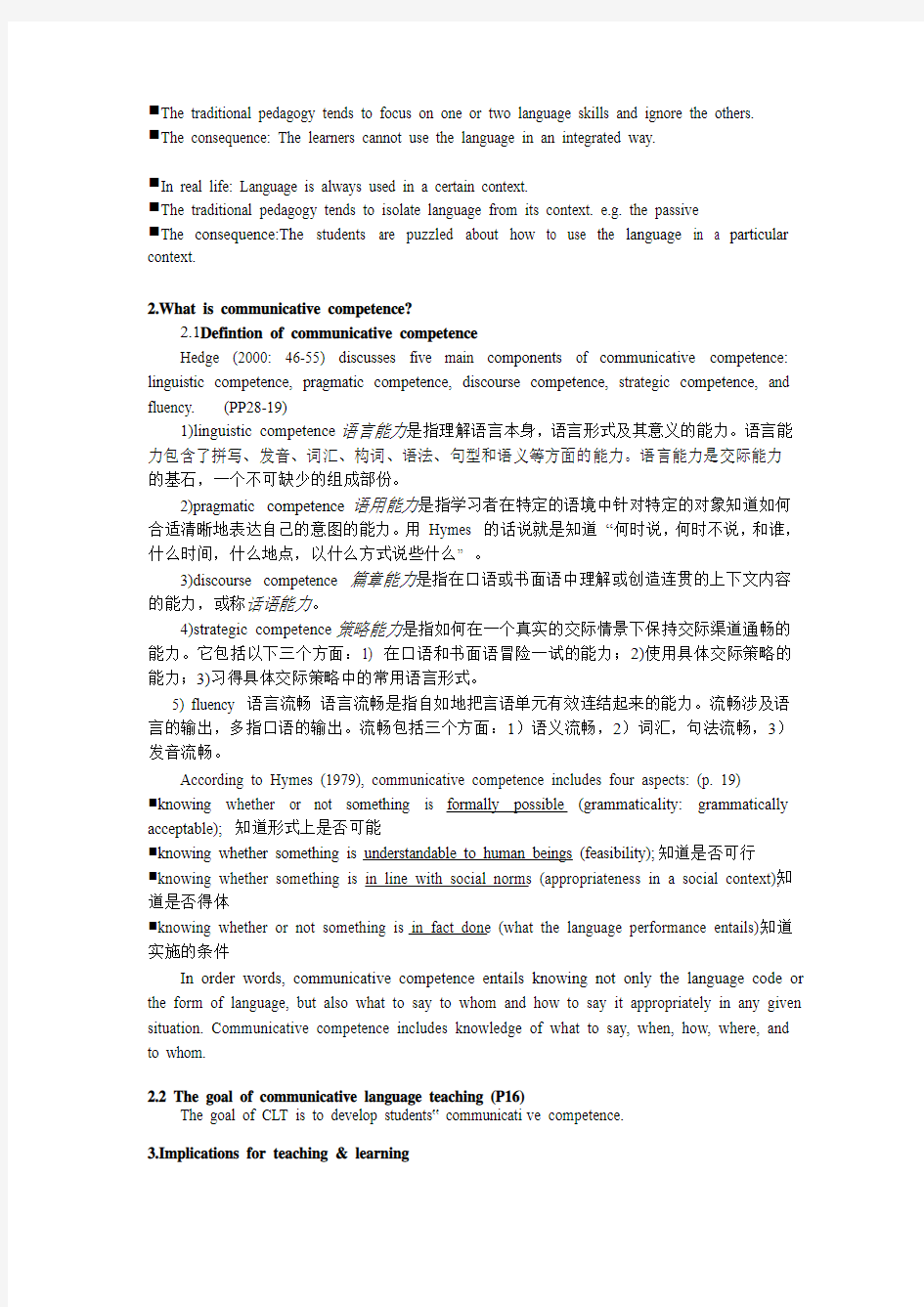Autonomous-learning


Unit 2 Communicative Principles and Task-basked Language
Teaching
Objectives:
By the end of this unit, Ss will:
1.Get to know about the CLT approach.
2.Get to know the definition of communicative competence.
3.Get to know how to evaluate communicative classroom activities
4.Get to understand Task-based Language Teaching.
Important points
1. the definition of communicative competence
2. how to evaluate communicative classroom activities
Difficult points
1.The CLT approach.
2. Task-based Language Teaching
Teaching methods
Reflective Cooperative Autonomous-learning Model, Lecture, Discussion
Teaching Procedures
Step 1 Lead-in
1. Ss do the reading report.
2.Ss discuss :
a. What is the traditional foreign language teaching like?
b. What is the language use in real life like?
c. What is our final goal of language learning?
Step 2 Presentation
https://www.sodocs.net/doc/ba17149632.html,nguage use in real life vs. traditional pedagogy
The teacher sums up what students have discussed and then sums up the differences between Language use in real life vs. traditional pedagogy.
The ultimate goal of FLT is: to enable the learners to use the foreign language in work or life. Therefore, we should teach: that part of the language that will be used; in the way that is used in the real world. Gaps between the use of language in real life and the traditional foreign language teaching pedagogy: (pp. 14-16)
In real life: Language is used to perform certain communicative functions.
The traditional pedagogy: focuses on forms rather than on functions.
The consequence: The learners have learned a lot of sentences or patterns, but they are unable to use them appropriately in real social situations.
In real life: We use all skills, including the receptive skills and the productive skills.
The traditional pedagogy tends to focus on one or two language skills and ignore the others.
The consequence: The learners cannot use the language in an integrated way.
In real life: Language is always used in a certain context.
The traditional pedagogy tends to isolate language from its context. e.g. the passive
The consequence:The students are puzzled about how to use the language in a particular context.
2.What is communicative competence?
2.1Defintion of communicative competence
Hedge (2000: 46-55) discusses five main components of communicative competence: linguistic competence, pragmatic competence, discourse competence, strategic competence, and fluency. (PP28-19)
1)linguistic competence语言能力是指理解语言本身,语言形式及其意义的能力。语言能力包含了拼写、发音、词汇、构词、语法、句型和语义等方面的能力。语言能力是交际能力的基石,一个不可缺少的组成部份。
2)pragmatic competence语用能力是指学习者在特定的语境中针对特定的对象知道如何合适清晰地表达自己的意图的能力。用Hymes 的话说就是知道“何时说,何时不说,和谁,什么时间,什么地点,以什么方式说些什么” 。
3)discourse competence 篇章能力是指在口语或书面语中理解或创造连贯的上下文内容的能力,或称话语能力。
4)strategic competence策略能力是指如何在一个真实的交际情景下保持交际渠道通畅的能力。它包括以下三个方面:1) 在口语和书面语冒险一试的能力;2)使用具体交际策略的能力;3)习得具体交际策略中的常用语言形式。
5) fluency 语言流畅语言流畅是指自如地把言语单元有效连结起来的能力。流畅涉及语言的输出,多指口语的输出。流畅包括三个方面:1)语义流畅,2)词汇,句法流畅,3)发音流畅。
According to Hymes (1979), communicative competence includes four aspects: (p. 19)
knowing whether or not something is formally possible (grammaticality: grammatically acceptable); 知道形式上是否可能
knowing whether something is understandable to human beings (feasibility);知道是否可行
knowing whether something is in line with social norms (appropriateness in a social context);知道是否得体
knowing whether or not something is in fact done (what the language performance entails).知道实施的条件
In order words, communicative competence entails knowing not only the language code or the form of language, but also what to say to whom and how to say it appropriately in any given situation. Communicative competence includes knowledge of what to say, when, how, where, and to whom.
2.2 The goal of communicative language teaching (P16)
The goal of CLT is to develop students? communicati ve competence.
3.Implications for teaching & learning
4. Three principles of communicative language teaching (P20)
Three principles suggested by Richards and Rodgers(1986:72)
1) Communication principle: Activities that involve real communication promote learning.
2) Task principle: Activities in which language is used for carrying out meaningful task promote learning.
3) Meaningfulness principle: Language that is meaningful to learner supports the learning process.
Howatt(1984)指出,交际教学法流派中可分出“温和派”和“激进派”两种:
“温和派”强调向学习者提供使用英语进行交际的机会的重要性,将这类交际活动置于更大范围的语言教学中。可以称作“学用英语”(Learning to use English),成为近年来交际教学法的主流。
“激进派”声称语言是通过交际习得的,因此这并不是一个激活已有的知识的问题,而是一个促进掌握语言系统本身的问题。可称作“用英语学英语”(using English to learn it)。
5. CLT & the teaching of language skills
The translation of communicative competence in language teaching practice is to develop the learners? skills, namely, listening, speaking, reading and writing.
In traditional pedagogy, listening and speaking were treated as skills different from what takes place in reality.
Therefore, listening and speaking skills need to be redefined in terms of the real communicative use.
Students should have the chance to listen to and produce what is meaningful, authentic, unpredictable, and creative if ever possible.
Listening and reading are both interpretative or receptive skills.
Traditionally the purpose of reading is to learn language, namely vocabulary, grammar, etc., and reading is regarded as a process of decoding, structural analysis, etc.
In CLT, reading is to extract the meaning or the messages, and the students use different skills, e.g. skimming and scanning (see Unit 10), for different reading purposes.
In CLT, students have the chance to write to express their own feelings or describe their own experiences, thus making the practice of writing meaningful and authentic.
In short, CLT has expanded the area:
Language content (to incorporate functions);
Learning process (cognitive style and information processing); and
Product (language skills).
6. Main features of Communicative activities
6.1A sequence of activities represented in Communicative Language Teaching(Cambridge University Press) by Littlewood (1981: 86):
功能互动活动(Functional communicative activities)
e.g.: 比较不同图画的异同、推断图画中事件发生的可能顺序、发现地图或图画中的缺失部分等等之类的活动
社会交往活动(Social Interaction activities)
e.g.:谈话和讨论、对话和角色扮演、模拟、即兴表演和辩论等之类的活动。
A communicative lesson does not consist of only communicative activities. For communicative activities to take place, the teacher needs to start from controlled structural activities to social problem solving activities.
6.2 Six Criteria for evaluating communicative classroom activities
https://www.sodocs.net/doc/ba17149632.html,municative purpose; (information gap)
https://www.sodocs.net/doc/ba17149632.html,municative desire; (real need)
3.(Focus on ) Content, not form; (message)
4.Variety of language; (not just one language form, free to improvise/create)
5.No teacher intervention; (done by Ss; no correcting/evaluating how Ss do it; assessment is
based on the …product? or on communicative purpose rather than on the language.)
6.No material control.
For examples please refer to Wang Qiang?s book (2006) pp. 24-26
Rod Ellis罗德·埃利斯教授曾获得英国伦敦大学博士学位,现为新西兰奥克兰大学教授。主要研究领域为第二语言习得与第二语言教学。Rod Ellis教授在国际应用语言学和第二语言习得领域具有卓著的学术声誉,发表了许多学术专著,编写了一系列英语教程,并在许多国际著名学术刊物上发表了具有学科前沿理论与观点的论文。
7. Task-based Language Teaching (TBLT)
Task-based Language teaching is, in fact, a further development of Communicative Language Teaching. It shares the same beliefs, as language should be learned as close as possible to how it is used in real life. It has stressed the importance to combine form-focused teaching with communication-focused teaching.
1) Definitions of a task (P28)
2) Four components of a task (P28)
3) The differences between tasks and exercises (PP28-30)
8 PPP & Task-based Language Teaching
8.1 The Models of the Process of FLT外语教学模式
1 The PPP Model: Presentation(讲授)--- Practice(操练)---Production(产出)
2 Harmer' s ESA Model:Engage(投入)--- Study(学习)--- Activate(运用)
3 Ur's PPT Model
4 Willis' TBL Model:Pre – task(活动前)--- Task Cycle(任务周期)--- Language Focus
(语言点)
5 The 5-step teaching method: Revision(复习) ---Presentation(呈现)---Practice(实践)---
Drill(操练)---Consolidation(巩固)
8.2 The PPP Model & The 5-step teaching method
(A) 3P Model (B) 5-step Model
Warming-up Step I. Revision
Step I. Presentation Step II. Presentation
1. --- 1. ---
2. --- 2. ---
3. --- 3. ---
Step II. Practice Step III.Drills
1. --- 1. ---
2. --- 2. ---
3. --- 3. ---
Step III. Production Step IV. Practice
1. --- 1. ---
2. --- 2. ---
3. --- 3. ---
Homework Step V. Consolidation
Homework
8.3The differences between PPP & TBLT
For more details please refer to Wang Qiang?s book (2006) pp. 31-33
9. How to design tasks
Step 1 Think about student?s needs, interest, and abilities
Step 2 Brainstorm possible tasks
Step 3 Evaluating the list
Step 4 Choose the language items
Step 5 Preparing the materials
10. Appropriateness of CLT &TBLT in the Chinese context
For more details please refer to Wang Qiang?s boo k (2006) pp. 35-36
Step 3 Summary
1.Gaps between the use of language in real life and the traditional foreign language teaching
pedagogy;
2.Goal of CTL: Communicative competence;
3.Features of CLT, and Richards and Rodgers? three principles of CLT: com municative, task
and meaningfulness principles
https://www.sodocs.net/doc/ba17149632.html,municative activities (Littlewood):
functional communicative activities, and social interactional activities
5.Rod Ellis? six criteria for communicative activities
6.Task-based Language Teaching (TBLT)
Homework
1. What is communicative competence?
2. What are the three principles of communicative language teaching?
3. What are the six criteria for evaluating communicative classroom activities?
4. What is Task-based Language Teaching?
